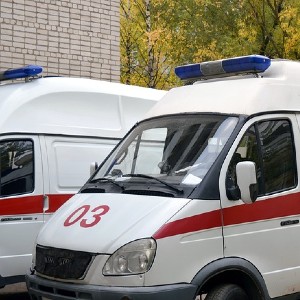The organization of ambulance decontamination during the COVID-19 pandemic: a process analysis based on the Lean Thinking philosophy

Accepted: 12 September 2023
All claims expressed in this article are solely those of the authors and do not necessarily represent those of their affiliated organizations, or those of the publisher, the editors and the reviewers. Any product that may be evaluated in this article or claim that may be made by its manufacturer is not guaranteed or endorsed by the publisher.
The COVID-19 pandemic led to massively increased emergency medical services (EMS) activity. The need to decontaminate emergency vehicles after conveying a suspected or confirmed patient to the hospital represented a critical step, slowing the activities and impacting the number of available ambulances. This brief paper analyzes the flow of EMS processes according to the Lean Thinking management approach, which focuses on reducing waste in a production cycle. The different steps of the whole process (arrival to the Emergency Department, handover phase, decontamination, return to service, and the required transfers) and a series of strategies are discussed. The organization (centralized or delocalized), number, and location of the decontamination centers impact transfers and waiting times and, consequently, the availability of ambulances. Optimizing these processes may lead to a global performance improvement, reducing transfers and time, with greater availability of emergency vehicles.
Lawal AK, Rotter T, Kinsman L, et al. Lean management in health care: definition, concepts, methodology and effects reported (systematic review protocol). Syst Rev 2014;3:103. DOI: https://doi.org/10.1186/2046-4053-3-103
Deblois S, Lepanto L. Lean and Six Sigma in acute care: a systematic review of reviews. Int J Health Care Qual Assur 2016;29:192-208. DOI: https://doi.org/10.1108/IJHCQA-05-2014-0058
Rotter T, Plishka C, Lawal A, et al. What Is Lean Management in Health Care? Development of an Operational Definition for a Cochrane Systematic Review. Eval Health Prof 2019;42:366-390. DOI: https://doi.org/10.1177/0163278718756992
Prado-Prado JC, García-Arca J, Fernández-González AJ, Mosteiro-Añón M. Increasing Competitiveness through the Implementation of Lean Management in Healthcare. Int J Environ Res Public Health 2020;17:4981. DOI: https://doi.org/10.3390/ijerph17144981
Sheperd CC. Lean for Government: Eliminating the Seven Wastes. NTRS-NASA Technical Reports Server. January 1, 2012. Accessed October 8, 2022. Available from: https://ntrs.nasa.gov/archive/nasa/casi.ntrs.nasa.gov/20120016881.pdf
Breen LM, Trepp R Jr, Gavin N. Lean Process Improvement in the Emergency Department. Emerg Med Clin North Am 2020;38:633-646. DOI: https://doi.org/10.1016/j.emc.2020.05.001
Zepeda-Lugo C, Tlapa D, Baez-Lopez Y, et al. Assessing the Impact of Lean Healthcare on Inpatient Care: A Systematic Review. Int J Environ Res Public Health 2020;17:5609. DOI: https://doi.org/10.3390/ijerph17155609
Tlapa D, Zepeda-Lugo CA, Tortorella GL, et al. Effects of Lean Healthcare on Patient Flow: A Systematic Review. Value Health 2020;23:260-273. DOI: https://doi.org/10.1016/j.jval.2019.11.002
Holden RJ. Lean Thinking in emergency departments: a critical review. Ann Emerg Med 2011;57:265-278. DOI: https://doi.org/10.1016/j.annemergmed.2010.08.001
Bucci S, de Belvis AG, Marventano S, et al. Emergency Department crowding and hospital bed shortage: is Lean a smart answer? A systematic review. Eur Rev Med Pharmacol Sci 2016;20:4209-4219.
Baldovin T, Amoruso I, Paganini M, et al. SARS-CoV-2 Contamination of Ambulance Surfaces and Effectiveness of Routine Decontamination Procedure: A Classic Hygiene Lesson for A Novel Pathogen. Int J Environ Res Public Health 2022;19:13646. DOI: https://doi.org/10.3390/ijerph192013646
Gómez-Castillo MA, Rivera Romero C, Reátegui-Ochoa K, et al. Ozone Efficacy for the Disinfection of Ambulances Used to Transport Patients during the COVID-19 Pandemic in Peru. Int J Environ Res Public Health 2023;20:5776. DOI: https://doi.org/10.3390/ijerph20105776
Estienney M, Daval-Frerot P, Aho-Glélé LS, et al. Use of a Hydrogen Peroxide Nebulizer for Viral Disinfection of Emergency Ambulance and Hospital Waiting Room. Food Environ Virol 2022;14:217-221. DOI: https://doi.org/10.1007/s12560-022-09519-y
Lindsley WG, McClelland TL, Neu DT, et al. Ambulance disinfection using Ultraviolet Germicidal Irradiation (UVGI): Effects of fixture location and surface reflectivity. J Occup Environ Hyg 2018;15:1-12. DOI: https://doi.org/10.1080/15459624.2017.1376067
Kumar A, Hasija V, Sudhaik A, et al. The practicality and prospects for disinfection control by photocatalysis during and post-pandemic: A critical review. Environ Res 2022;209:112814. DOI: https://doi.org/10.1016/j.envres.2022.112814
Istituto superiore di sanità. Raccomandazioni ad interim sulla sanificazione di strutture non sanitarie nell’attuale emergenza COVID-19: ambienti /superfici. Rapporto ISS COVID-19 n. 12/2021. Accessed October 12, 2022. Available form: https://www.iss.it/documents/20126/0/Rapporto+ISS+COVID-19+12_2021.pdf
Galanis P, Vraka I, Fragkou D, Bilali A, Kaitelidou D. Impact of personal protective equipment use on health care workers' physical health during the COVID-19 pandemic: A systematic review and meta-analysis. Am J Infect Control 2021;49:1305-1315. DOI: https://doi.org/10.1016/j.ajic.2021.04.084
McCann-Pineo M, Li T, Barbara P, et al. Factors Influencing Use of Personal Protective Equipment Among Emergency Medical Services Responders During the COVID-19 Pandemic: A Retrospective Chart Review. West J Emerg Med 2022;23:396-407. DOI: https://doi.org/10.5811/westjem.2022.2.55217
Copyright (c) 2023 the Author(s)

This work is licensed under a Creative Commons Attribution-NonCommercial 4.0 International License.
PAGEPress has chosen to apply the Creative Commons Attribution NonCommercial 4.0 International License (CC BY-NC 4.0) to all manuscripts to be published.


 https://doi.org/10.4081/ecj.2023.11646
https://doi.org/10.4081/ecj.2023.11646







